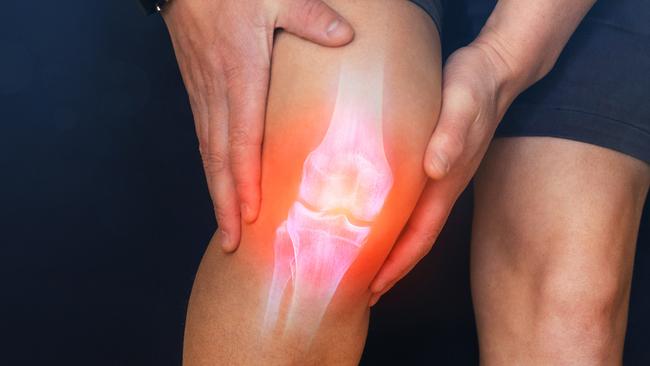Study uncovers hundreds of new genetic risk factors for osteoarthritis
It’s a debilitating disease affecting millions. Now scientists have uncovered new insights into how osteoarthritis happens, paving the way for better treatments.

The world’s largest study of its type has uncovered new genetic links to osteoarthritis and provided greater insights into how the disease works, clearing the way for more targeted medications.
The genome-wide association study has identified more than 500 new genetic links to the disease, as well as new potential drug targets which could offer relief to millions of patients.
Osteo is the most common form of arthritis and is a painful, degenerative disease that affects the whole joint, including bone, cartilage, ligaments and muscles. It can result in inflammation, chronic pain, stiffness and reduced mobility, which can severely impact a person’s quality of life.
It’s also common. Multiple scientific studies and the World Health Organisation estimate it affects anywhere from 528 million to 595 million people globally. That figure is expected to jump to one billion by 2050. Despite how prevalent and devastating the disease is, no cure has been discovered. So existing drugs target symptoms, but not the cause.
It can develop at any age, but is more prevalent in people over 40, and more women are affected than men. For a long time, it was thought osteoarthritis was the result of wear and tear, plus ageing. While modifications like weight-bearing exercises and maintaining a healthy weight can be beneficial in lowering a person’s risk, modern research has allowed scientists to realise the role of genetics. These findings extend that knowledge even further.
“We discovered over 900 genetic associations, 500 of which have never been reported before, providing fresh insights into the genetic landscape of the disease,” said professor Eleftheria Zeggini, the study’s lead author.
“We integrated diverse biomedical datasets and identified 700 genes with high confidence as being involved in osteoarthritis, advancing our understanding of the disease.”

Professor Zeggini is the director of the Institute of Translational Genomics, which sits within Helmholtz Munich, a German research centre. It led the study with input from researchers from around the world, including from Australia’s QIMR Berghofer.
The genome study analysed data from genetic samples donated by nearly two million people globally, including nearly 490,000 people diagnosed with the disease and thousands of Australians.
The findings have been published in the journal Nature Genetics and unlock new insights into the building blocks of the disease, which is critically important if a cure is to be found.
“We identified eight biological processes that are key to osteoarthritis development,” Professor Zeggini said.
“The overlap of genes across these biological processes suggests that these pathways interact to affect osteoarthritis development and progression. Targeted interventions regulating one or more of these eight processes could play a significant role in slowing or even halting disease progression.”

Ten per cent of the genes implicated are already targeted by existing approved medications, which raises the possibility they could be repurposed to accelerate treatment options.
If that happens, it means scientists would be able to skip early-stage clinical testing that typically aims to ensure a medication is safe, because that will have already been proven. Instead, they could jump to later stage trials, slashing the amount of time needed to test if a drug works.
Associate professor Michelle Lupton is part of the team from QIMR Berghofer that contributed to the study and says the findings are important for science and, in time, patients.
“There’ll be some drugs that come up which are kind of known to be useful for arthritis, but also it could uncover new drugs that are existing drugs that are used for other purposes,” Professor Lupton said.
“One example … the data showed new processes that weren’t necessarily known to be causally involved in osteoarthritis. So, one of them was to do with circadian rhythm, or kind of the body’s internal clock that regulates our sleep patterns. Those point to, potentially, drugs used to regulate your circadian rhythm could be useful.”

“The other example was in glial cell function. These cells have roles in immune defence and repair within the nervous system. New drugs that affect this disease pathway could be useful. So it gives clues to drugs that could go into clinical trials.”
David Liew is a rheumatologist and the medical director of Arthritis Australia. He has reviewed the findings. He said easing the pain and discomfort patients experienced would also reduce the economic and social burden of the disease.
“Part of the issue with osteoarthritis at the moment is that we don’t have good drug targets and that we don’t have any medicines at all that can actually modify the disease process for any type of osteoarthritis,” he said.
“It confers a massive burden on, not just on patients, but on our society. In fact, Arthritis Australia commissioned some work last year projecting out to (the year) 2040 and 5.39 million Australians are expected to have arthritis by 2040, of which osteoarthritis is meant to be 3.11 million of those.
“So we’re really talking about a big proportion of the country and, also, these aren’t just diseases of older people. We are increasingly talking about a large part of the productive workforce affected by osteoarthritis.
“I think the really interesting part of this data is that there are potentially drug targets that we can use that might help modify the disease process of osteoarthritis and, in particular, some of those might be targeted by existing medicines. So if there are repurposing opportunities where we can use existing medicines, that’s all the more powerful, because those medicines might potentially be quicker to bring to people living with arthritis.”





To join the conversation, please log in. Don't have an account? Register
Join the conversation, you are commenting as Logout